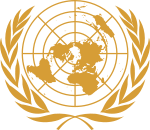- United Nations Security Council resolution
-
UN Security Council Resolutions Sources:
UN Security Council · UNBISnet · Wikisource1 to 100 (1946–1953) 101 to 200 (1953–1965) 201 to 300 (1965–1971) 301 to 400 (1971–1976) 401 to 500 (1976–1982) 501 to 600 (1982–1987) 601 to 700 (1987–1991) 701 to 800 (1991–1993) 801 to 900 (1993–1994) 901 to 1000 (1994–1995) 1001 to 1100 (1995–1997) 1101 to 1200 (1997–1998) 1201 to 1300 (1998–2000) 1301 to 1400 (2000–2002) 1401 to 1500 (2002–2003) 1501 to 1600 (2003–2005) 1601 to 1700 (2005–2006) 1701 to 1800 (2006–2008) 1801 to 1900 (2008–2009) 1901 to 2000 (2009–2011) 2001 to 2100 (2011–present) A United Nations Security Council resolution is a UN resolution adopted by the fifteen members of the Security Council; the UN body charged with "primary responsibility for the maintenance of international peace and security".
The UN Charter specifies (in Article 27) that a draft resolution on non-procedural matters is adopted if nine or more of the fifteen Council members vote for the resolution, and if it is not vetoed by any of the five permanent members. Draft resolutions on "procedural matters" can be adopted on the basis of an affirmative vote by any nine Council members.
The five permanent members are the People's Republic of China (which replaced the Republic of China in 1971), France, the Russian Federation (which replaced the defunct Soviet Union in 1991) the United Kingdom, and the United States.
Contents
Terms and functions mentioned in the UN Charter
The term "resolution" does not appear in the text of the United Nations Charter. It contains numerous formulations, such as "decision" or "recommendation", which imply the adoption of resolutions which do not specify the method to be used.
The UN Charter is a multilateral treaty. It is the constitutional document that distributes powers and functions among the various UN organs. It authorizes the Security Council to take action on behalf of the members, and to make decisions and recommendations. The Charter mentions neither binding nor non-binding resolutions. The International Court of Justice (ICJ) advisory opinion in the 1949 "Reparations" case indicated that the United Nations Organization had both explicit and implied powers. The Court cited Articles 104 and 2(5) of the Charter, and noted that the members had granted the Organization the necessary legal authority to exercise its functions and fulfill its purposes as specified or implied in the Charter, and that they had agreed to give the United Nations every assistance in any action taken in accordance with the Charter.[1]
Article 25 of the Charter says that "The Members of the United Nations agree to accept and carry out the decisions of the Security Council in accordance with the present Charter". The Repertory of Practice of United Nations Organs, a UN legal publication, says that during the United Nations Conference on International Organization which met in San Francisco in 1945, attempts to limit obligations of Members under Article 25 of the Charter to those decisions taken by the Council in the exercise of its specific powers under Chapters VI, VII and VIII of the Charter failed. It was stated at the time that those obligations also flowed from the authority conferred on the Council under Article 24(1) to act on the behalf of the members while exercising its responsibility for the maintenance of international peace and security.[2] Article 24, interpreted in this sense, becomes a source of authority which can be drawn upon to meet situations which are not covered by the more detailed provisions in the succeeding articles.[3] The Repertory on Article 24 says: "The question whether Article 24 confers general powers on the Security Council ceased to be a subject of discussion following the advisory opinion of the International Court of Justice rendered on 21 June 1971 in connection with the question of Namibia (ICJ Reports, 1971, page 16)".[4]
In exercising its powers the Security Council seldom bothers to cite the particular article or articles of the UN Charter that its decisions are based upon. In cases where none are mentioned, a constitutional interpretation is required.[5] This sometimes presents ambiguities as to what amounts to a decision as opposed to a recommendation, and also the relevance and interpretation of the phrase "in accordance with the present Charter".[6]
Resolutions by the Security Council are legally binding if they are made under Chapter VII (Action with Respect to Threats to the Peace, Breaches of the Peace, and Acts of Aggression) of the Charter. If the council cannot reach consensus or a passing vote on a resolution, they may choose to produce a non-binding presidential statement instead of a Resolution. These are adopted by consensus. They are meant to apply political pressure — a warning that the Council is paying attention and further action may follow.
Press statements typically accompany both resolutions and presidential statements, carrying the text of the document adopted by the body and also some explanatory text. They may also be released independently, after a significant meeting.
See also
- United Nations Security Council resolutions by topic
Notes
- ^ See ICJ Advisory Opinion, Reparation for Injuries Suffered in the Service of the United Nations [1]
- ^ See page 5, The Repertory of Practice of United Nations Organs, Extracts Relating to Article 25 [2]
- ^ see The Repertory of Practice of United Nations Organs, Extracts Relating to Article 24, [3]
- ^ See Note 2 on page 1 of Sup. 6, vol. 3, Article 24
- ^ See Repertoire Of The Practice Of The Security Council, introductory note regarding the contents and arrangement of Chapter VIII [4]
- ^ Schweigman, David "The authority of the Security Council under Chapter VII of the UN Charter". 2001. Martinus Nijhoff Publishers: The Hague
External links
- Complete list and text of all resolutions
- UN Security Council Official Website including full text of all resolutions
- How to Find General Assembly and Security Council Resolutions and Voting Records
Categories:- United Nations Security Council resolutions
Wikimedia Foundation. 2010.


